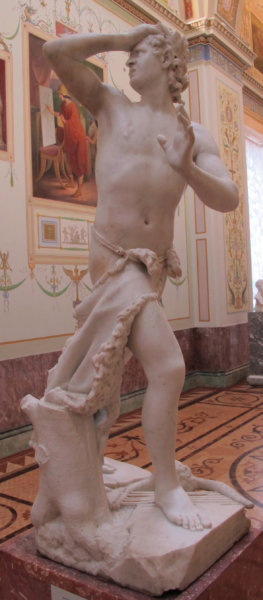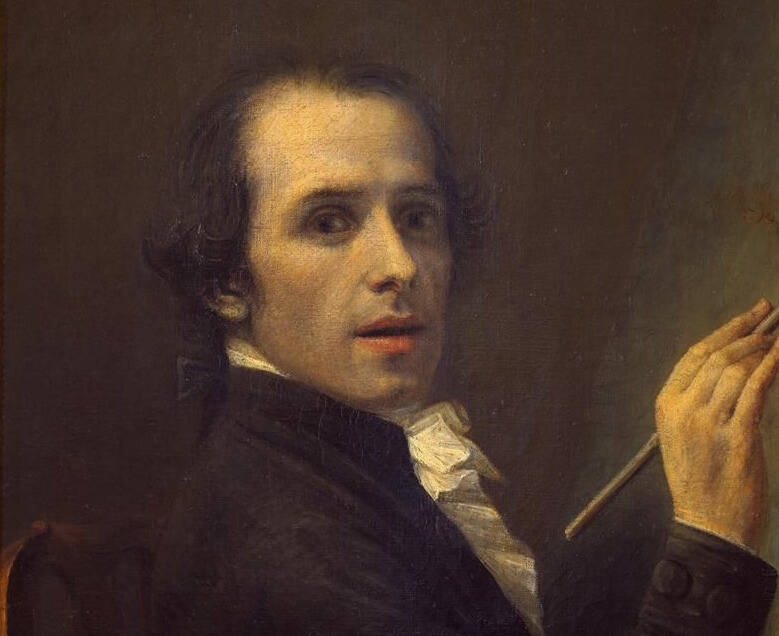Two centuries ago, on the morning of October 13, 1822, in Venice “died a sublime Christian” the artist for whose work “the sculpture came out renewed”, as we read on the memorial tablet placed on the door of his Roman studio: Antonio Canova.[1]
He was born 65 years earlier, on November 1, 1757 in Possagno, a small town in the province of Treviso, northeastern Italy. The paternal grandfather Pasino (†1794), a skilled stonemason, initiated the little Canova to stone work. At the age of 11, Antonio went to Venice where he studied the art of drawing and attended the school of nude at the Accademia delle Belle Arti. He became a protagonist of Neoclassicism, or the return to the forms and beauty of ancient Greece and Rome.
In Venice he modeled the first monumental sculptures: Orpheus and Eurydice, Dædalus and Icarus.

In 1779 he went to Rome, where he sculpted masterpieces such as Psyche Revived by Cupid’s Kiss (1793), his most famous work, and the four dedicated to the popes: Tomb of Clement XIV (1783), Tomb of Pope Clement XIII (1792), the Bust of Pius VII (1805) and Pius VI praying (1821). His works are too many to mention. Appointed Inspector General of Antiquities and Fine Arts of the Papal States in 1802 by Pope Pius VII (†1823), in 1815 Canova set to work, with success, for the return to Rome of the works stolen by Napoleon (†1821) from the Roman States, under the terms of the Treaty of Tolentino (1797).
The great sculptor often returned to his birthplace, where he grappled with painting. In 1818, instead of repairing the parish church of Possagno he took “the resolution to have a new one built, at my expense…”[2] It was the Temple of Canova, or rather the Church of the Most Holy Trinity, which joins the circular cell of the Roman Pantheon to the pronaos columns of the Parthenon. Canova’s old stomach trouble become more and more acute.
Close to St. Mark’s Square in Venice, after having the Sacraments that prepare the dying to meet the living God, half an hour before dying “that pure and beautiful soul was at that moment in conversation with God.”[3] He uttered these last words: “O Lord! You have given me the good that I have had in this world, and you take it back from me: blessed be your name forever!” He left by testament, among other things, “to the Supreme Pontiff Pope Pius VII, his constant benefactor, whatever object of his inheritance that could be most grateful to him.”[4]
The solemn funeral was celebrated in Rome on January 31, 1823 in the Basilica dei Santi XII Apostoli (of the Twelve Holy Apostles), set up by the Academy of St. Luke (an association of artists founded in 1593), of which the sculptor was member, in the presence of the chamberlain and the Senate of Rome. The organization was entrusted to the Roman architect Giuseppe Valadier (†1839), who
above all else, imagined the most famous sacred sculptures made by Canova should contribute to adorn the funeral pomp of their author. For which he arranged in the middle of the church a majestic but simple monument of white marble. […] The solemn Requiem Mass was pontificated by His Most Reverend Excellency Monsignor [Carlo] Zen [†1825], Archbishop of Calcedonia, secretary of the Sacred Congregation of Bishops and Regulars, Venetian patrician and sung with two orchestras with music by the famous Jommella conducted by maestro Mr. [Pietro] Terziani [†1831]. The talented tenor Mr. [Giovanni] David [†1864] volunteered to honor the memory of Canova and sang, with his usual skill, the verse Benedictus, expressly written by maestro Terziani.[5]
For such an important circumstance in 1823 was chosen, albeit re-instrumented “for two orchestras,” a score written in Stuttgart, southwestern Germany, in 1756 for the funeral of the mother of the Württemberg Duke Carl Eugen: the remarkable Requiem of the composer from Aversa, southern Italy, Niccolò Jommelli (†1774), church and theater musician, one of the most important figures of the Neapolitan school of music. It is the most famous Missa pro defunctis before Mozart’s unfinished one.
https://youtu.be/gC85yxEmxEg
It is conceived for solos (soprano, alto, tenor and bass), strings and basso continuo (a form of improvised accompaniment at the organ or harpsichord, typical of the 17th and 18th centuries). In the solo passages we can recognize the hand of the opera composer; the choral ones, created in a simple but effective way, are partly written in the stile antico, with baroque counterpoint, and partly alternate with the soloists with numerous suspended dissonances.
May listening to this “moving, beguiling and full of surprises” Requiem be our musical commemoration of that shining glory of the Catholic Church, generously protected and kindly favored by the Roman Pontificate, which was Antonio Canova.[6]
[1] M. Missirini, Della vita di Antonio Canova, Milano 1825, p. 417, our translation.
[2] Lettere familiari inedite di A. Canova, Venice 1835, p. 87, our translation.
[3] Missirini, ibidem, p. 197.
[4] Missirini, ibidem, p. 200, our translation.
[5] Diario di Roma, 5 febbraio 1823. pp. 2-11.
[6] K. G. Fellerer, Der Palestrinastil und seine Bedeutung in der vokalen Kirchenmusik des 18 Jahrhunderts, Augsburg 1929, p. 160, our translation.


